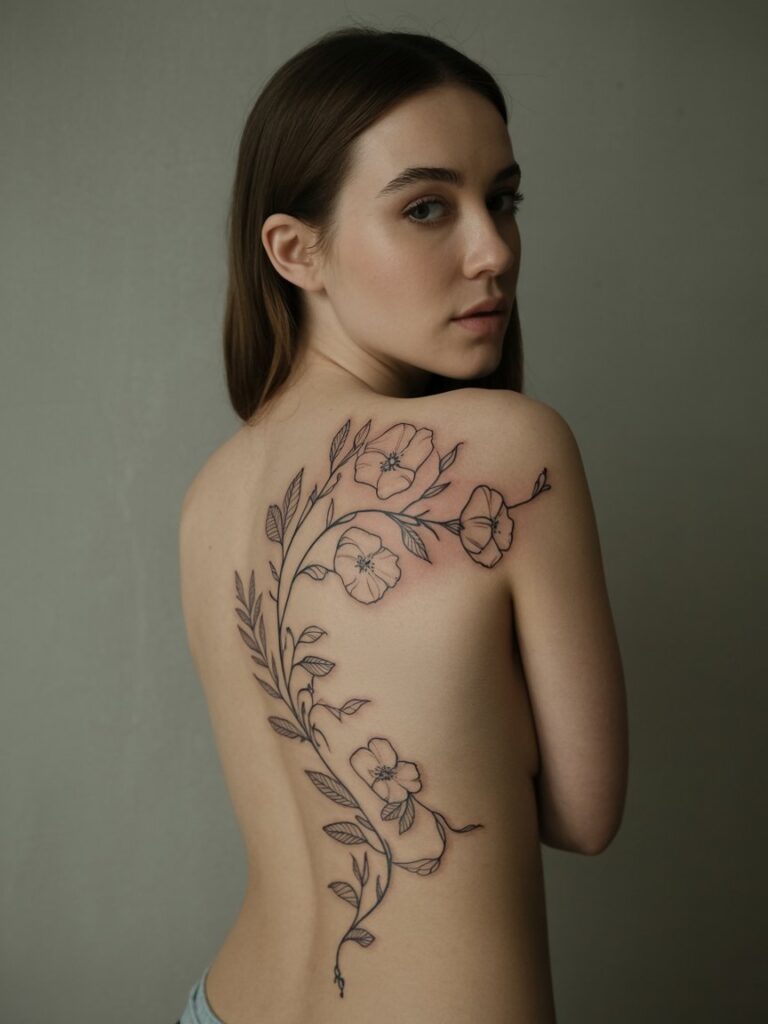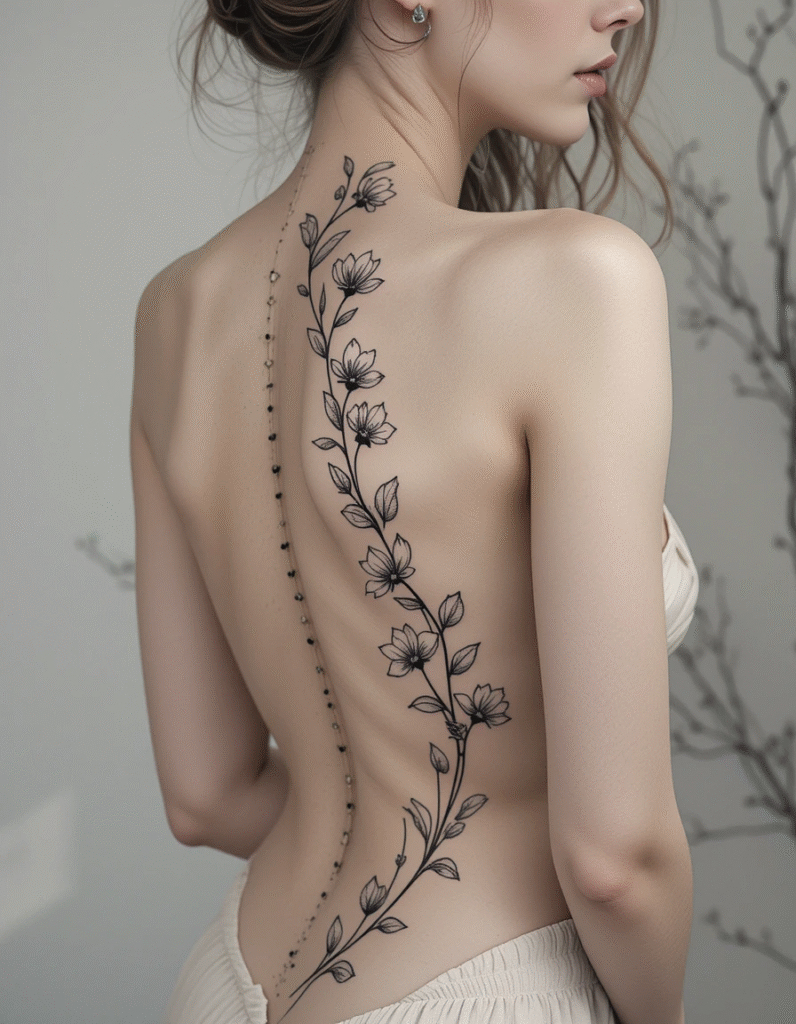In the sophisticated realm of contemporary tattoo artistry, few design concepts capture the intersection of natural beauty, feminine strength, and symbolic depth like botanical spine tattoos. These magnificent works of body art transform the human spine into a living canvas where flora and anatomy unite in perfect harmony, creating statements that speak to both aesthetic excellence and profound personal transformation. The stunning tattoos showcased here demonstrate how contemporary artists elevate botanical imagery into sophisticated expressions of growth, resilience, and the eternal dance between strength and delicacy that defines the modern feminine spirit.
The Poetry of Botanical Symbolism: Understanding Floral Spine Art
Botanical spine tattoos represent far more than decorative floral arrangements—they embody centuries of symbolic meaning woven through cultures that have long recognized flowers as messengers of life’s most profound truths, carrying meanings that span from personal metamorphosis to universal wisdom about growth, resilience, and the cyclical nature of existence.
The Spine as Life’s Central Column
The human spine serves as both anatomical foundation and symbolic axis, representing:
- Structural Integrity: The backbone as source of physical strength and upright posture
- Nervous Pathway: The spinal column as conduit for life’s vital energies and conscious awareness
- Growth Metaphor: Vertebral development paralleling personal evolution and spiritual maturation
- Flexibility Balance: The spine’s combination of strength and adaptability reflecting life’s demands
- Central Axis: The body’s core line representing one’s essential self and unwavering principles
- Sacred Geography: The spine as spiritual pathway connecting earth-bound existence to higher consciousness
When adorned with botanical imagery, the spine becomes a garden of meaning, transforming anatomical structure into artistic statement that celebrates both physical beauty and metaphorical significance.
The Language of Flowers: Botanical Symbolic Vocabulary
Floral spine tattoos embody multiple layers of symbolic meaning through their distinctive botanical elements:
- Roses: Classic symbols of love, passion, beauty, and the complex balance between pleasure and pain
- Peonies: Representations of honor, wealth, romance, and the fleeting nature of life’s most beautiful moments
- Wild Flowers: Symbols of natural freedom, untamed beauty, and authentic self-expression
- Lily Blossoms: Emblems of purity, rebirth, and spiritual transformation across cultural traditions
- Vine Patterns: Representations of growth, connection, persistence, and life’s interconnected nature
- Leaf Details: Symbols of renewal, seasonal change, and the continuous cycle of death and rebirth
This rich botanical vocabulary makes floral spine tattoos powerful expressions of feminine identity that operate on multiple symbolic levels, connecting personal growth narratives to universal natural cycles.
The Art of Botanical Translation in Contemporary Tattoo Culture
These floral spine tattoos represent a sophisticated approach to nature-inspired body art, demonstrating how traditional botanical symbolism can be transformed into stunning contemporary expressions through masterful technique and artistic sensitivity.
Technical Mastery in Botanical Art Execution
The technical execution visible in these pieces showcases several advanced tattoo techniques essential for botanical imagery:
- Organic Line Work: Creating flowing, natural curves that mirror actual plant growth patterns and botanical structure
- Shading Gradation: Using subtle tonal variations to achieve dimensional depth and realistic floral texture
- Negative Space: Strategic use of skin tone to enhance floral silhouettes and create breathing room within compositions
- Anatomical Integration: Designing botanical elements that complement and enhance the spine’s natural curvature
- Scale Relationships: Balancing floral elements of different sizes to create harmonious and proportionally pleasing arrangements
- Detail Rendering: Executing intricate botanical features like petal textures, leaf veining, and stamen details with precision
This level of technical execution requires exceptional skill in both botanical illustration and advanced tattoo application, representing the highest standards of contemporary nature-inspired body art.

The Philosophy of Nature Art Translation
These botanical designs embody important principles of translating natural beauty into tattoo form:
- Botanical Accuracy: Respecting actual plant structures while adapting for artistic composition and aesthetic impact
- Organic Enhancement: Elevating natural forms through sophisticated design principles and contemporary artistic vision
- Symbolic Purpose: Ensuring artistic choices serve meaningful expression rather than mere decorative function
- Timeless Quality: Creating designs that honor both natural beauty and enduring aesthetic principles
- Technical Excellence: Demanding flawless execution since nature-inspired art tolerates no compromise in quality
- Compositional Harmony: Maintaining visual balance despite complex botanical information and symbolic density
This approach reflects deep understanding of both natural forms and contemporary aesthetic needs, creating tattoos that serve as genuine expressions of botanical appreciation rather than superficial floral decoration.
Historical Context and Cultural Traditions
Floral spine tattoos connect to millennia of human fascination with botanical symbolism and the artistic representation of nature’s beauty, representing one of humanity’s most enduring and universal artistic traditions.
The Development of Botanical Art Traditions
The tradition of floral artistic expression emerged from centuries of cultural development and symbolic evolution:
- Ancient Civilizations: Egyptian, Greek, and Roman use of botanical motifs in art, architecture, and personal adornment
- Medieval Herbalism: European traditions connecting plant knowledge with healing, spirituality, and feminine wisdom
- Renaissance Naturalism: Artistic movements emphasizing accurate botanical illustration and scientific observation
- Victorian Flower Language: Complex symbolic systems using floral arrangements to communicate emotions and messages
- Art Nouveau Movement: Late 19th-century emphasis on organic forms and natural beauty in decorative arts
- Contemporary Botanical Art: Modern movements celebrating both scientific accuracy and artistic interpretation of natural forms
This rich historical development provides floral spine tattoos with deep cultural roots and connection to centuries of human artistic and symbolic tradition.

Symbolic Significance and Cultural Meaning
Botanical imagery carries profound significance within human cultural tradition:
- Feminine Identity: Flowers as traditional symbols of feminine beauty, strength, and life-giving power
- Growth Metaphors: Plant development as parallel to personal evolution and spiritual maturation
- Seasonal Cycles: Botanical changes reflecting life’s natural rhythms and transformative processes
- Beauty Philosophy: Flowers representing humanity’s aesthetic appreciation and artistic sensibility
- Life Celebration: Botanical abundance as symbol of vitality, creativity, and natural abundance
- Connection Symbols: Plants as representations of humanity’s essential relationship with natural world
These cultural depths make floral spine tattoos powerful tools for maintaining connection to natural wisdom and feminine symbolic traditions.
Cultural Contexts and Artistic Movements
Botanical imagery draws from rich traditions of nature-inspired art spanning centuries of artistic development and cultural expression across diverse civilizations and aesthetic movements.
European Botanical Art Heritage
The floral artistic tradition emerged from Europe’s greatest naturalistic and decorative movements:
- Medieval Illumination: Manuscript traditions featuring intricate botanical borders and symbolic floral elements
- Renaissance Herbalism: Scientific and artistic documentation of plant life combining accuracy with aesthetic beauty
- Baroque Garden Design: Formal botanical arrangements emphasizing both natural beauty and human artistic intervention
- Romantic Naturalism: 18th-century emphasis on emotional connection to natural beauty and organic forms
- Pre-Raphaelite Movement: Victorian artistic traditions featuring detailed botanical accuracy and symbolic meaning
- Art Nouveau Aesthetics: Turn-of-century emphasis on organic curves and natural forms in decorative arts
This artistic heritage provides floral spine tattoos with sophisticated visual vocabulary and deep cultural resonance.
Global Botanical Artistic Traditions
Floral themes manifest differently across various cultural and artistic traditions:
- Japanese Hanakotoba: Traditional flower language and symbolic systems embedded in cultural practice
- Chinese Flower Painting: Classical traditions emphasizing both technical skill and philosophical meaning
- Indian Floral Motifs: Complex botanical patterns in traditional textiles and architectural decoration
- Islamic Garden Design: Traditions creating paradise imagery through sophisticated botanical arrangements
- Mexican Floral Folk Art: Vibrant traditions celebrating natural abundance and cultural identity
- Contemporary Global Botanical Art: Modern international movements bridging scientific accuracy with artistic expression
Understanding these global variations helps create tattoos that reflect authentic connection to specific cultural and artistic contexts.
The Psychology of Botanical Identity and Feminine Expression
Choosing floral spine tattoos reflects deep psychological connections to natural beauty, feminine identity, and the human need for growth and transformation expressed through botanical metaphors.
The Language of Growth: Botanical Psychology
Floral spine tattoos often reflect psychological patterns related to personal development and feminine identity:
- Growth Orientation: Active engagement with personal development and continuous self-improvement
- Beauty Appreciation: Deep aesthetic sensitivity and appreciation for natural and artistic beauty
- Feminine Identity: Connection to traditional and contemporary expressions of feminine strength and grace
- Transformation Embrace: Willingness to undergo personal change and embrace life’s developmental processes
- Natural Connection: Psychological need for relationship with natural world and organic rhythms
- Strength Integration: Combining traditional feminine qualities with contemporary expressions of personal power
These psychological connections make floral spine tattoos particularly meaningful for individuals navigating feminine identity development and personal growth.

The Botanical Mindset: Living with Natural Wisdom
The human attraction to botanical imagery reveals important psychological truths:
- Growth Celebration: Recognition that personal development is natural, beautiful, and worthy of artistic expression
- Beauty Integration: Understanding that aesthetic appreciation enhances rather than diminishes authentic living
- Seasonal Acceptance: Embracing life’s natural cycles of growth, dormancy, and renewal
- Organic Patience: Developing understanding that meaningful change occurs gradually and naturally
- Feminine Strength: Recognizing that traditional feminine qualities represent genuine forms of power and wisdom
- Natural Rhythm: Aligning personal development with organic timing rather than artificial urgency
Floral spine tattoos serve as permanent reminders of these natural principles and their relevance to navigating contemporary life through botanical wisdom and feminine awareness.
Placement and Composition Strategies for Botanical Imagery
The strategic placement of these floral spine tattoos demonstrates sophisticated understanding of how botanical body art interacts with anatomy, movement, and the natural curves that define feminine beauty and strength.
The Spine as Botanical Garden
The spinal placement provides unique opportunities for botanical display:
- Vertical Canvas: The spine’s length allowing for flowing botanical compositions that mirror natural growth patterns
- Anatomical Harmony: Working with the body’s natural curves to enhance rather than fight anatomical structure
- Movement Integration: Botanical imagery that flows naturally with posture changes and daily movement
- Symbolic Alignment: Positioning growth imagery along the body’s structural center and strength source
- Intimate Revelation: Placement creating special moments of botanical sharing and personal disclosure
- Feminine Geography: Utilizing the spine’s role in defining feminine silhouette and graceful posture
This placement choice reflects deep consideration of both aesthetic impact and symbolic function in daily life and personal identity.

Scale and Proportion in Botanical Composition
The sizing demonstrates sophisticated understanding of botanical art principles:
- Organic Scaling: Varying floral element sizes to create natural hierarchy and visual interest
- Anatomical Proportion: Sizing botanical elements to complement rather than overwhelm the spine’s proportions
- Growth Patterns: Arranging floral elements to suggest natural development and organic expansion
- Negative Space: Using untattooed areas to provide visual rest and enhance botanical silhouettes
- Focal Points: Creating emphasis through scale variation that guides the eye through the botanical composition
- Integration Balance: Achieving harmony between botanical complexity and anatomical elegance
This compositional sophistication demonstrates understanding of how successful botanical art requires both artistic skill and deep appreciation for natural design principles.
Feminine Dimensions of Botanical Symbolism
Beyond cultural and psychological factors, floral spine tattoos carry profound significance related to feminine identity, strength, and the celebration of qualities traditionally associated with feminine wisdom and beauty.
Traditional Feminine Symbolism in Botanical Art
In cultural tradition, flowers represent fundamental feminine realities:
- Life Creation: Botanical imagery as symbol of feminine creative power and life-giving capacity
- Beauty Standards: Flowers representing ideals of feminine beauty that transcend cultural and temporal boundaries
- Nurturing Wisdom: Plant growth as metaphor for feminine capacity to nurture and support development
- Seasonal Intuition: Botanical cycles reflecting feminine understanding of natural timing and organic rhythm
- Strength Disguise: Delicate floral appearance concealing the tremendous strength required for growth and survival
- Transformation Mastery: Plant metamorphosis as parallel to feminine capacity for personal and relational change
These symbolic dimensions make floral spine tattoos powerful tools for expressing authentic feminine identity and connection to traditional wisdom.
Contemporary Feminine Expression Through Botanical Art
Botanical imagery offers modern insights about feminine identity and empowerment:
- Strength Redefinition: Understanding that feminine strength often manifests through growth rather than dominance
- Beauty Reclamation: Embracing aesthetic appreciation as legitimate form of wisdom and personal expression
- Natural Authority: Recognizing that feminine power often operates through organic influence rather than force
- Growth Leadership: Understanding that feminine leadership often focuses on development rather than control
- Authentic Expression: Using botanical imagery to express genuine feminine identity beyond social expectations
- Wisdom Integration: Combining traditional feminine qualities with contemporary empowerment and personal agency
These contemporary insights transform floral spine tattoos into expressions of evolved feminine identity that honors both traditional wisdom and modern empowerment.
Modern Femininity and Botanical Art
Floral spine tattoos create unique opportunities for expressing contemporary feminine identity, personal empowerment, and commitment to authentic self-expression in modern cultural contexts.
Botanical Art in Contemporary Feminine Culture
These tattoos complement and enhance modern feminine identity expression:
- Empowerment Aesthetics: Botanical imagery as sophisticated alternative to aggressive or masculine expressions of strength
- Authentic Beauty: Embracing natural aesthetic appreciation as legitimate aspect of contemporary feminine identity
- Growth Celebration: Using botanical metaphors to celebrate personal development and continuous self-improvement
- Feminine Community: Connecting with other women who appreciate both beauty and strength in botanical expression
- Professional Integration: Maintaining feminine aesthetic appreciation within contemporary career and achievement contexts
- Identity Balance: Combining traditional feminine beauty with modern expressions of personal power and independence
Thoughtful integration helps floral spine tattoos enhance overall feminine identity while providing opportunities for authentic self-expression and community connection.
Lifestyle Alignment and Natural Living
Floral spine tattoos often reflect and influence lifestyle choices related to natural beauty and holistic well-being:
- Natural Beauty: Commitment to authentic aesthetic choices that enhance rather than mask natural beauty
- Garden Connection: Active engagement with plants, gardening, and direct relationship with natural growth processes
- Seasonal Living: Aligning personal rhythms with natural cycles and seasonal changes
- Aesthetic Cultivation: Developing sophisticated appreciation for beauty in both natural and artistic contexts
- Wellness Integration: Connecting botanical imagery with holistic approaches to health and well-being
- Creative Expression: Using botanical inspiration in other areas of creative work and artistic development
These lifestyle connections create coherent identity expression that extends far beyond the tattoo itself into comprehensive natural living and aesthetic appreciation.
Choosing the Right Artist for Botanical Excellence
The sophisticated beauty and symbolic complexity of floral spine tattoos require specialized expertise in botanical illustration and understanding of feminine aesthetic principles.
Technical Requirements for Botanical Art
Artists specializing in floral imagery must demonstrate:
- Botanical Knowledge: Understanding of actual plant structures and natural growth patterns
- Feminine Sensitivity: Appreciation for feminine beauty standards and aesthetic preferences
- Line Work Excellence: Exceptional skill in creating flowing, organic curves and natural transitions
- Shading Mastery: Advanced ability to create dimensional depth and realistic botanical textures
- Compositional Understanding: Knowledge of design principles that create harmonious and balanced arrangements
- Portfolio Evidence: Previous work demonstrating competence in sophisticated botanical illustration
The delicate nature of floral spine tattoos demands artists who approach botanical imagery with both technical excellence and aesthetic sensitivity.
Artistic Vision and Collaborative Spirit
Beyond technical competence, the right artist should demonstrate:
- Botanical Appreciation: Genuine love for natural beauty and understanding of plant symbolism
- Feminine Understanding: Sensitivity to feminine aesthetic preferences and identity expression needs
- Collaborative Approach: Willingness to work with clients to achieve personally meaningful botanical results
- Quality Standards: Commitment to excellence befitting sophisticated botanical art and feminine beauty
- Design Innovation: Ability to create original compositions rather than copying existing botanical designs
- Professional Respect: Understanding that floral spine tattoos represent significant personal investment and identity expression
The relationship between artist and client becomes particularly important for achieving botanical authenticity and feminine beauty that these tattoos demand.
Regional Variations and Botanical Authenticity
Floral imagery manifests differently across various geographic and cultural regions, reflecting local botanical traditions and regional aesthetic preferences.
Regional Botanical Characteristics
Different geographic regions bring distinctive elements to floral tattoo imagery:
- English Garden Style: Formal botanical arrangements emphasizing classical proportions and refined aesthetic sensibility
- Wildflower Meadow: Natural, unstructured arrangements celebrating native plants and organic growth patterns
- Japanese Botanical Art: Minimalist compositions emphasizing seasonal beauty and symbolic meaning
- Mediterranean Flora: Sun-loving plants and herbs reflecting warmth, abundance, and natural vitality
- Tropical Botanical: Lush, abundant imagery celebrating exotic beauty and natural exuberance
- Desert Flowering: Hardy plants and seasonal blooms representing resilience and hidden beauty
These regional influences create culturally authentic versions of universal botanical themes.
Climate and Seasonal Considerations
Geographic location influences appropriate botanical choices:
- Native Plant Selection: Using local flora to create personally and geographically meaningful botanical imagery
- Seasonal Timing: Considering natural blooming cycles when planning botanical tattoo compositions
- Climate Symbolism: Incorporating regional growing conditions into symbolic meaning and personal significance
- Cultural Plant Traditions: Understanding local botanical folklore and traditional plant meanings
- Landscape Integration: Creating botanical imagery that reflects personal connection to specific geographic locations
- Environmental Awareness: Choosing plants that represent commitment to local ecosystem health and natural conservation
Understanding these geographic factors helps create tattoos that reflect authentic connection to specific places and regional botanical traditions.
The Economics of Botanical Art Investment
Quality floral spine tattoos represent significant artistic and financial investments requiring careful consideration and planning for optimal results.
Pricing Factors for Botanical Excellence
Several elements influence the cost of superior botanical spine tattoos:
- Artist Specialization: Premium pricing for specialists in botanical illustration and feminine aesthetic design
- Design Complexity: Intricate floral arrangements requiring extensive botanical knowledge and artistic skill
- Size and Coverage: Spinal length allowing for elaborate compositions but requiring extended application time
- Detail Density: Fine botanical elements like leaf veining and petal texture requiring meticulous attention
- Studio Reputation: Established shops with proven track records in sophisticated botanical and feminine work
- Geographic Location: Regional variations in pricing and botanical art specialist availability
Understanding these cost factors helps in budgeting appropriately for work that will provide lasting aesthetic value and personal meaning.
Long-term Botanical and Artistic Value
The investment in floral spine tattoos extends beyond initial application:
- Aesthetic Durability: How botanical imagery maintains beauty and clarity throughout aging and life changes
- Artistic Aging: Quality botanical art improving with time as lines soften and colors mature naturally
- Touch-up Maintenance: Periodic care to preserve botanical detail and color vibrancy
- Style Evolution: How floral tattoos adapt to changing personal aesthetic preferences and fashion trends
- Identity Growth: Ongoing relevance as botanical imagery continues supporting feminine identity development
- Legacy Consideration: Floral spine tattoos as expression of beauty that may influence family and future generations
Viewing botanical spine tattoos as long-term aesthetic investments helps ensure decisions that provide lasting beauty and personal significance.
The Social Impact of Botanical Art in Contemporary Culture
Floral spine tattoos influence not only personal aesthetic identity but also broader cultural conversations about feminine beauty, natural appreciation, and the role of botanical imagery in modern life.
Beauty Standards and Natural Aesthetics
These tattoos contribute to important aesthetic conversations in contemporary culture:
- Natural Beauty: Botanical imagery as alternative to artificial or commercialized beauty standards
- Feminine Strength: Demonstrating that appreciation for beauty represents genuine form of feminine power
- Aesthetic Education: Encouraging broader cultural appreciation for botanical beauty and natural design
- Traditional Values: Supporting renewal of appreciation for classical feminine aesthetic principles
- Environmental Connection: Using botanical imagery to promote broader environmental awareness and natural conservation
- Artistic Appreciation: Inspiring others to engage with sophisticated botanical art and natural beauty
This aesthetic influence extends floral spine tattoos beyond personal beauty to active participation in cultural aesthetic development.
Building Community Through Botanical Appreciation
Floral spine tattoos create connections among individuals who share commitment to natural beauty and aesthetic excellence:
- Feminine Networks: Supporting communities of women who appreciate both beauty and strength in botanical expression
- Artistic Communities: Connecting with movements focused on botanical art and natural aesthetic appreciation
- Garden Culture: Building relationships through shared interest in plants, gardening, and natural beauty
- Environmental Groups: Connecting with individuals committed to natural conservation and ecosystem health
- Creative Networks: Strengthening bonds through shared aesthetic identity and artistic appreciation
- Mentorship Relationships: Supporting other women in developing confidence in aesthetic expression and natural beauty
These community-building functions make floral spine tattoos powerful tools for feminine social connection and mutual aesthetic support.
Conclusion: Wearing Nature’s Poetry as Personal Expression
Floral spine tattoos represent one of contemporary feminine culture’s most sophisticated and meaningful artistic traditions. These exquisite images unite humanity’s eternal fascination with botanical beauty with contemporary understanding of feminine strength and identity, creating deeply personal art that speaks to universal aesthetic longings while honoring individual connections to natural beauty and the growth that defines authentic personal development.
The exceptional examples showcased here demonstrate how skilled artists can transform traditional botanical imagery into powerful statements of remarkable beauty and profound personal significance. They invite us to consider our own relationships with natural beauty, feminine identity, personal growth, and the courage required to express authentic aesthetic appreciation while connecting us to the vast tradition of individuals who have found wisdom and inspiration in botanical symbolism.
For those drawn to the sophisticated beauty of floral imagery, these spine tattoos offer opportunities to wear one’s commitment to natural aesthetics, feminine strength, and personal growth as permanent body art. They represent not just aesthetic achievement, but statements of identity that honor both individual beauty and collective heritage rooted in humanity’s deepest appreciation for natural wonder.
In the expanding universe of tattoo artistry, botanical spine tattoos stand as testament to the power of combining natural symbolism with contemporary technique and personal aesthetic vision. They remind us that the most profound body art often emerges from humanity’s deepest connections to beauty, transformed through artistic skill and personal devotion into permanent celebrations of natural wonder and feminine grace.
These tattoos carry forward the wisdom of botanical tradition into contemporary life, suggesting that the appreciation for beauty, commitment to growth, and celebration of feminine strength remain relevant and necessary for flourishing in the complexities of modern existence. They represent art that doesn’t just adorn the body, but nourishes the soul with daily reminders of natural beauty and the eternal wisdom that emerges from conscious engagement with growth, transformation, and the flowering of authentic feminine identity.


